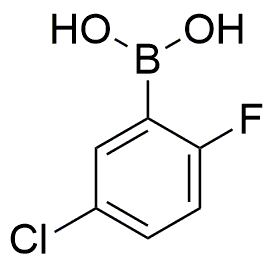5-Chloro-2-fluorophenylboronic acid is widely utilized in research focused on:
- Pharmaceutical Development: This compound plays a crucial role in synthesizing various pharmaceuticals, particularly in the development of targeted cancer therapies. Its ability to form stable complexes with biomolecules enhances drug efficacy.
- Organic Synthesis: It serves as a key building block in organic chemistry, allowing researchers to create complex molecules through Suzuki coupling reactions. This is particularly beneficial in the production of agrochemicals and fine chemicals.
- Material Science: The compound is used in the development of advanced materials, including polymers and nanomaterials, which can be applied in electronics and coatings due to their unique properties.
- Bioconjugation: It is utilized in bioconjugation techniques, enabling the attachment of biomolecules to surfaces or other molecules, which is essential in creating biosensors and diagnostic tools.
- Research in Catalysis: The compound is explored in catalytic processes, enhancing reaction rates and selectivity, which is vital for efficient chemical manufacturing and reducing waste in industrial processes.
Informations générales
Propriétés
Sécurité et réglementation
Applications
5-Chloro-2-fluorophenylboronic acid is widely utilized in research focused on:
- Pharmaceutical Development: This compound plays a crucial role in synthesizing various pharmaceuticals, particularly in the development of targeted cancer therapies. Its ability to form stable complexes with biomolecules enhances drug efficacy.
- Organic Synthesis: It serves as a key building block in organic chemistry, allowing researchers to create complex molecules through Suzuki coupling reactions. This is particularly beneficial in the production of agrochemicals and fine chemicals.
- Material Science: The compound is used in the development of advanced materials, including polymers and nanomaterials, which can be applied in electronics and coatings due to their unique properties.
- Bioconjugation: It is utilized in bioconjugation techniques, enabling the attachment of biomolecules to surfaces or other molecules, which is essential in creating biosensors and diagnostic tools.
- Research in Catalysis: The compound is explored in catalytic processes, enhancing reaction rates and selectivity, which is vital for efficient chemical manufacturing and reducing waste in industrial processes.
Documents
Fiches de données de sécurité (FDS)
La FDS fournit des informations de sécurité complètes sur la manipulation, le stockage et l’élimination du produit.
Spécifications du produit (PS)
Le PS fournit une description complète des propriétés du produit, notamment sa composition chimique, son état physique, sa pureté et les exigences de stockage. Il détaille également les plages de qualité acceptables et les applications prévues du produit.
Certificats d'analyse (COA)
Recherchez des certificats d'analyse (COA) en saisissant le numéro de lot du produit. Les numéros de lot et de lot se trouvent sur l'étiquette d'un produit, après les mots « Lot » ou « Lot de fabrication ».
Numéro de catalogue
Numéro de lot/série
Certificats d'origine (COO)
Ce certificat d'exploitation confirme le pays dans lequel le produit a été fabriqué, et détaille également les matériaux et composants utilisés et s'il est issu de sources naturelles, synthétiques ou autres sources spécifiques. Ce certificat peut être requis pour les douanes, le commerce et la conformité réglementaire.
Numéro de catalogue
Numéro de lot/série
Fiches de données de sécurité (FDS)
La FDS fournit des informations de sécurité complètes sur la manipulation, le stockage et l’élimination du produit.
DownloadSpécifications du produit (PS)
Le PS fournit une description complète des propriétés du produit, notamment sa composition chimique, son état physique, sa pureté et les exigences de stockage. Il détaille également les plages de qualité acceptables et les applications prévues du produit.
DownloadCertificats d'analyse (COA)
Recherchez des certificats d'analyse (COA) en saisissant le numéro de lot du produit. Les numéros de lot et de lot se trouvent sur l'étiquette d'un produit, après les mots « Lot » ou « Lot de fabrication ».
Numéro de catalogue
Numéro de lot/série
Certificats d'origine (COO)
Ce certificat d'exploitation confirme le pays dans lequel le produit a été fabriqué, et détaille également les matériaux et composants utilisés et s'il est issu de sources naturelles, synthétiques ou autres sources spécifiques. Ce certificat peut être requis pour les douanes, le commerce et la conformité réglementaire.


